The Intel Xeon Silver 4114 is the second highest SKU in the Intel Xeon Scalable Silver range. With 10 cores and modest clock speeds its closest relative in the Intel Xeon E5 V4 generation would be the Intel Xeon E5-2630 V4 or perhaps the Xeon E5-2630L V4. Priced at a 40% or so premium to the Intel Xeon Silver 4110 and Xeon Silver 4112, one gets a major benefit: this is the lowest cost 10 core CPU in the Xeon Scalable lineup. With that said, it brings into sharp focus the Intel pricing deltas in the Skylake-SP generation.
Key stats for the Intel Xeon Silver 4114: 10 cores / 20 threads, 2.2GHz base and 3.0GHz turbo with 13.75MB L3 cache. The CPU features a 85W TDP. This is a price point Intel has maintained for years. Here is the ARK page with the feature set.
Test Configuration
Here is our basic test configuration for single-socket Xeon Scalable systems:
- Motherboard: Supermicro X11SPH-nCTF
- CPU: Intel Xeon Silver 4114
- RAM: 6x 16GB DDR4-2400 RDIMMs (Micron)
- SSD: Intel DC S3710 400GB
- SATADOM: Supermicro 32GB SATADOM
One of the key advantages the Intel Xeon Silver series has is the ability to use up to 12 DIMMs per socket. Intel’s embedded platforms and quad-core Intel Xeon E3-1200 V6 series platforms cannot do this in 2017. DDR4-2400 is the fastest memory supported on the Xeon Silver platform which is why we are not using faster speeds.
Here is the lscpu output for the Silver 4114:
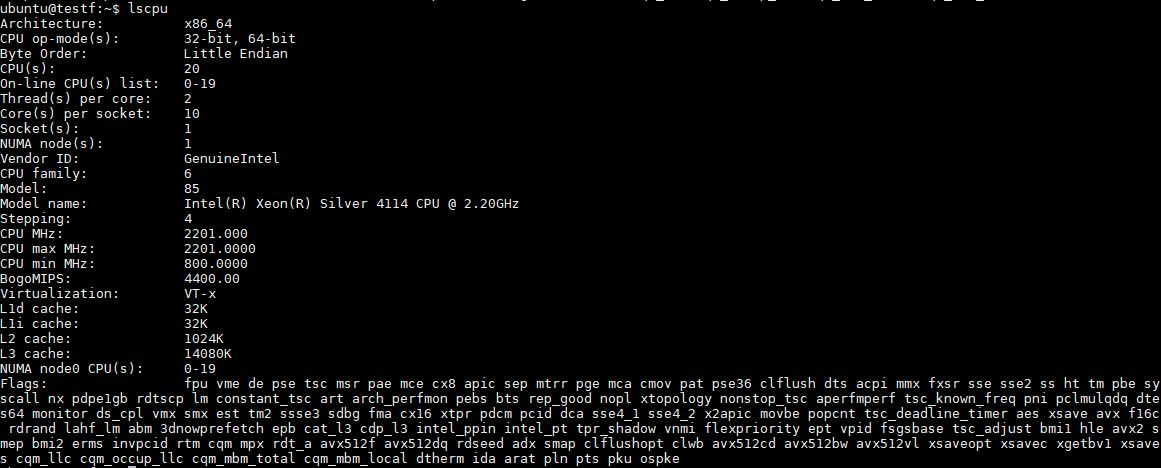
Single Intel Xeon Silver 4114 Benchmarks
For this exercise, we are using our legacy Linux-Bench scripts which help us see cross-platform “least common denominator” results. We do have a full set of expanded benchmarks from our next-gen test suite (Linux-Bench2) so expect to see those results sprinkled in as we get a larger comparison data set built.
Python Linux 4.4.2 Kernel Compile Benchmark
This is one of the most requested benchmarks for STH over the past few years. The task was simple, we have a standard configuration file, the Linux 4.4.2 kernel from kernel.org, and make the standard auto-generated configuration utilizing every thread in the system. We are expressing results in terms of compiles per hour to make the results easier to read.
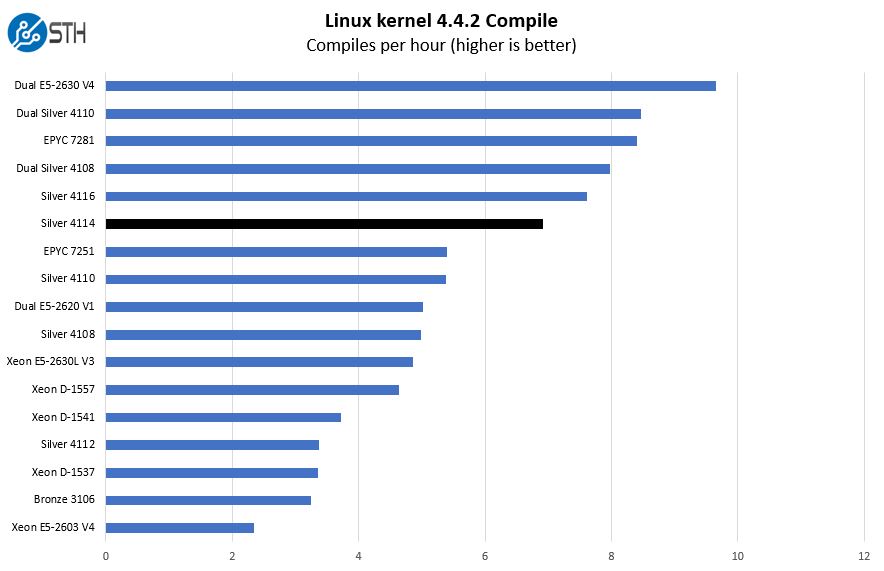
There are two keys to performance here. First, the base clocks creep up from the Xeon Silver 4110. Second, there are two additional cores. Those two factors combine to add significant performance.
c-ray 1.1 Performance
We have been using c-ray for our performance testing for years now. It is a ray tracing benchmark that is extremely popular to show differences in processors under multi-threaded workloads.
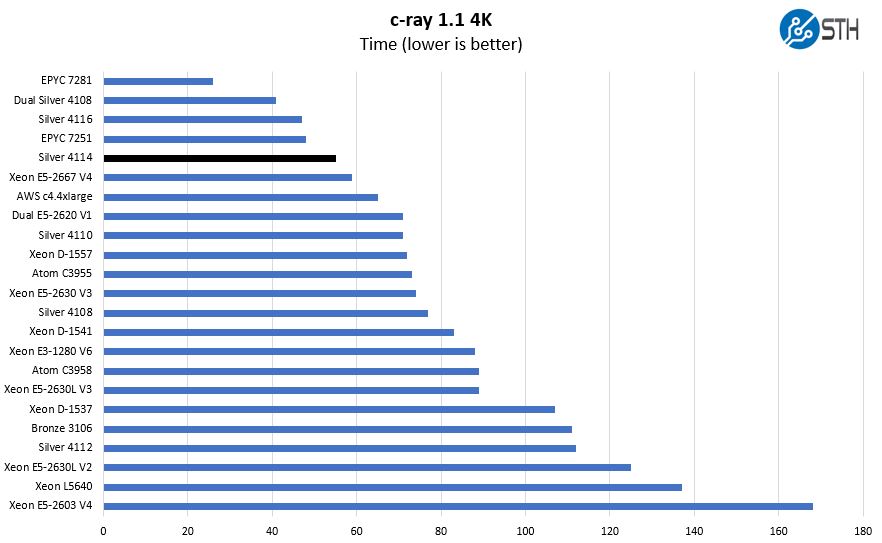
Here c-ray is hyper-sensitive to architectural differences. It is best used to compare CPUs within the same generations and families. Again, higher clock speeds and more cores help in the Xeon Silver line.
7-zip Compression Performance
7-zip is a widely used compression/ decompression program that works cross-platform. We started using the program during our early days with Windows testing. It is now part of Linux-Bench.
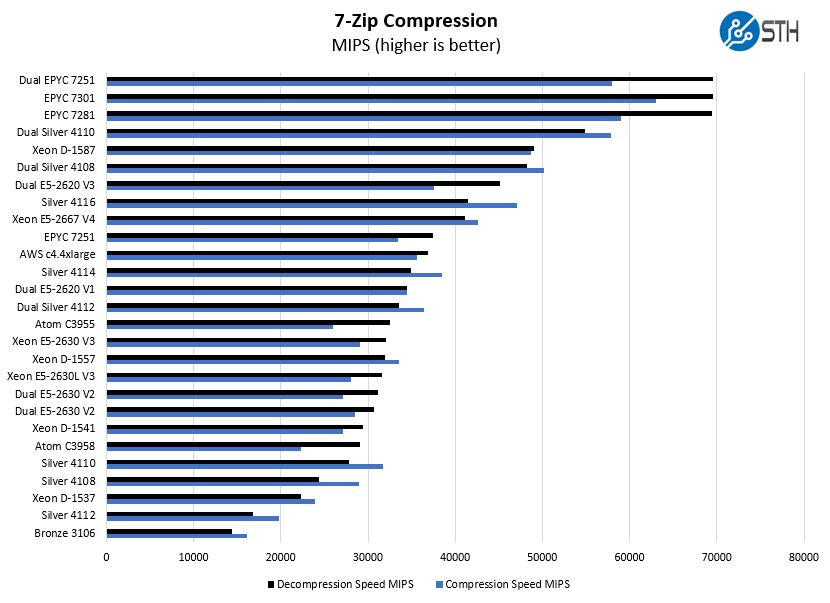
We found a number of decent comparison points and crammed them into this chart. The Xeon Silver 4114 single socket performance is about that of the AWS c4.4xlarge here. You can also notice significant separation between the 4110, 4114 and 4116.
NAMD Performance
NAMD is a molecular modeling benchmark developed by the Theoretical and Computational Biophysics Group in the Beckman Institute for Advanced Science and Technology at the University of Illinois at Urbana-Champaign. More information on the benchmark can be found here. We are going to augment this with GROMACS in the next-generation Linux-Bench in the near future. With GROMACS we have been working hard to support Intel’s Skylake AVX-512 and AVX2 supporting AMD Zen architecture. Here are the comparison results for the legacy data set:
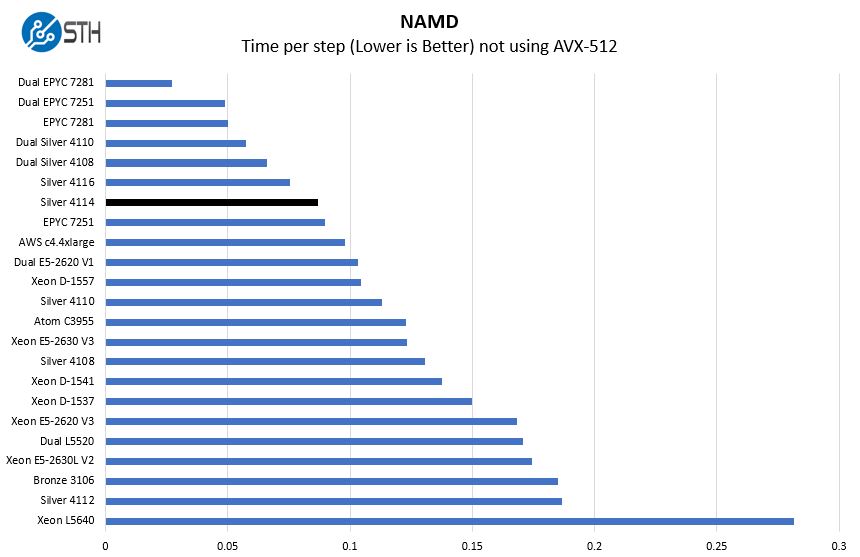
Although we are transitioning to GROMACS, our use of NAMD is still interesting as it shows some intriguing performance scaling through the different lines. Here one can see nice scaling between the 8, 10 and 12 core offerings in the Xeon Silver line (4110, 4114, and 4116 respectively.)
We also left the dual Xeon L5520, single hex-core L5640, and dual E5-2620 V1 results in there for a sense of performance compared to older generation parts that are due for upgrades.
Sysbench CPU test
Sysbench is another one of those widely used Linux benchmarks. We specifically are using the CPU test, not the OLTP test that we use for some storage testing.
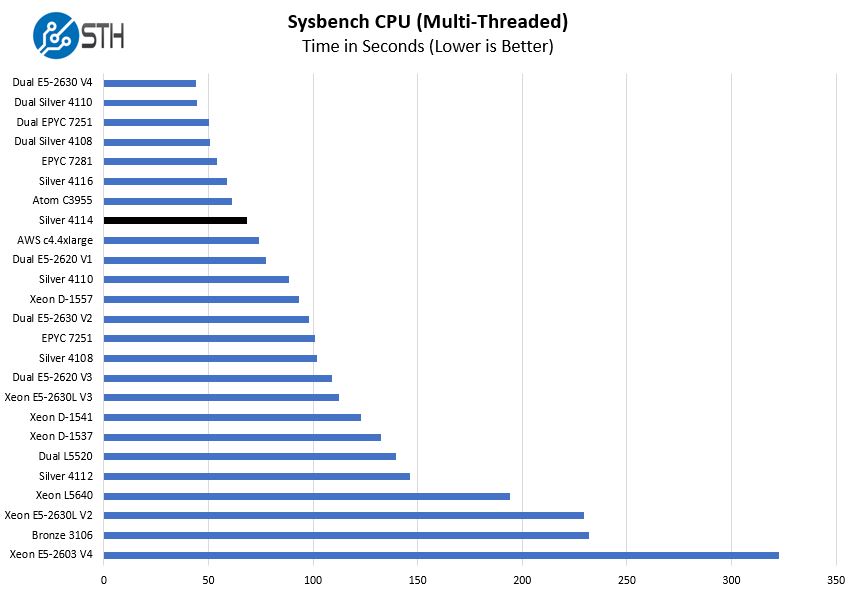
Here we see solid scaling in the Intel Xeon Silver line. What we did want to take a moment to show is single threaded performance:
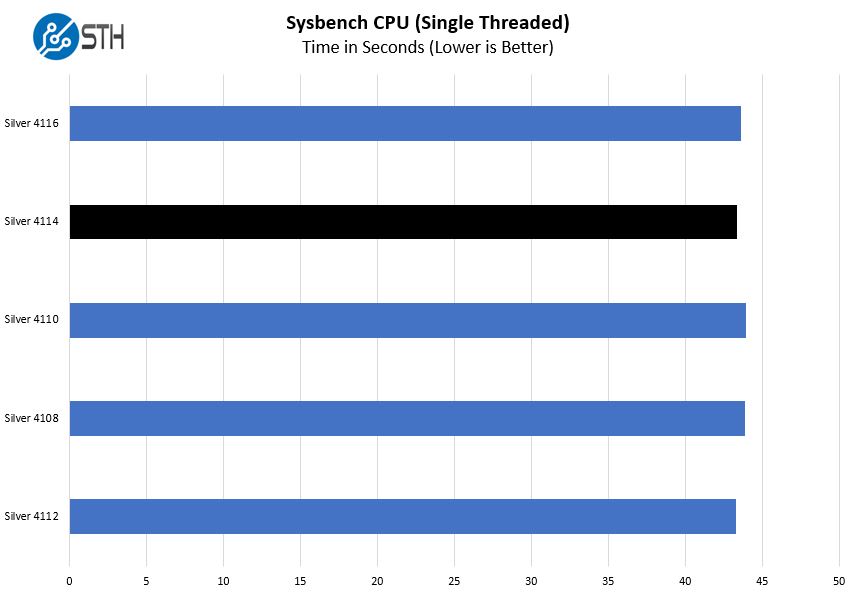
The key takeaway here is that the 3.0GHz max turbo essentially caps single-threaded performance for the Xeon silver line. If you are using only 1-2 cores, get the Silver 4108 and do not fool yourself into thinking spending almost twice as much for a CPU will make you better off.
OpenSSL Performance
OpenSSL is widely used to secure communications between servers. This is an important protocol in many server stacks. We first look at our sign tests:
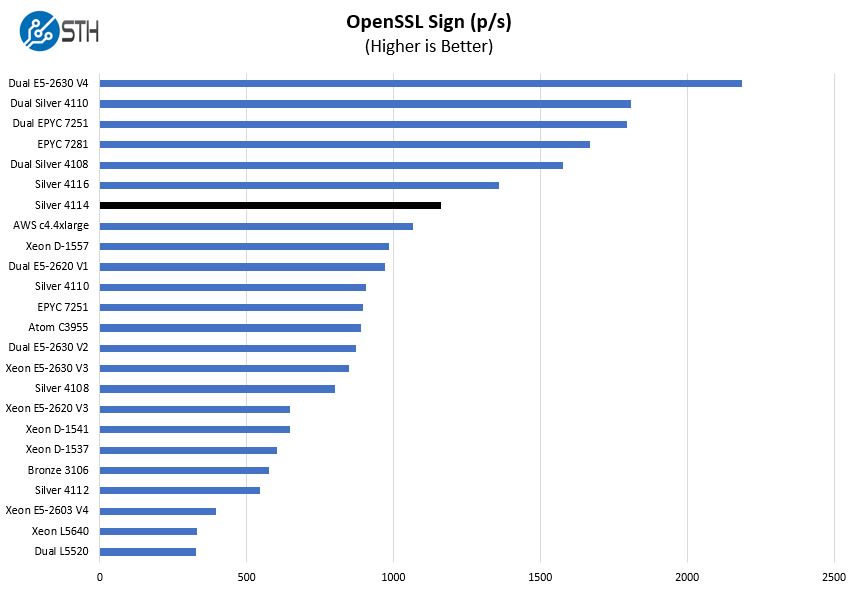
Here are the verify results:
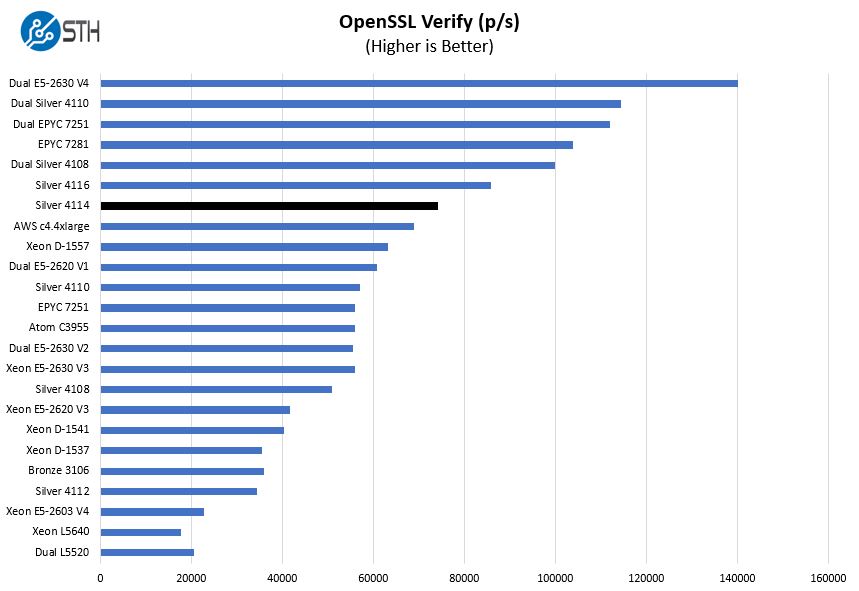
These are certainly solid results on the OpenSSL side and in-line with expectations.
UnixBench Dhrystone 2 and Whetstone Benchmarks
One longest-running tests is the venerable UnixBench 5.1.3 Dhrystone 2 and Whetstone results. They are certainly aging, however, we constantly get requests for them, and many angry notes when we leave them out. UnixBench is widely used so we are including it in this data set. Here are the Dhrystone 2 results:
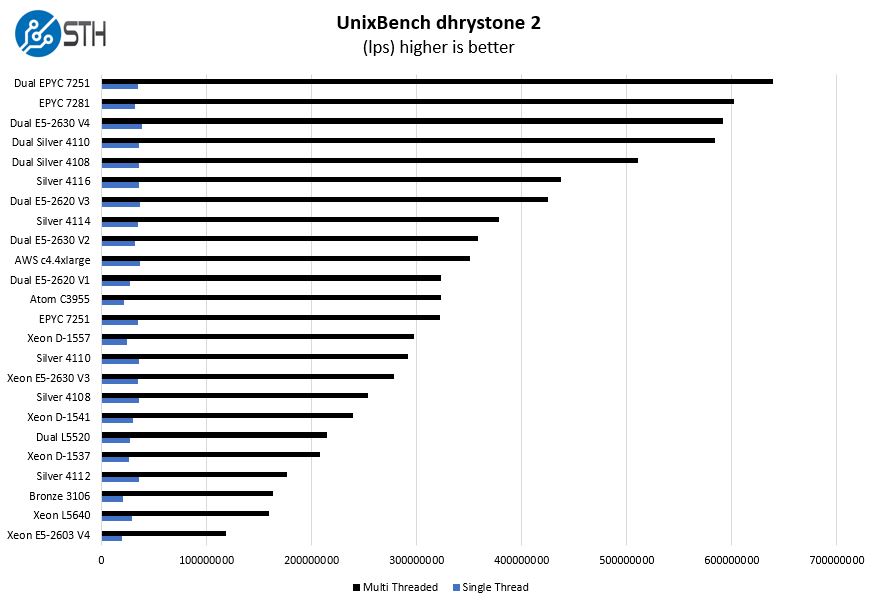
Here are the whetstone results:
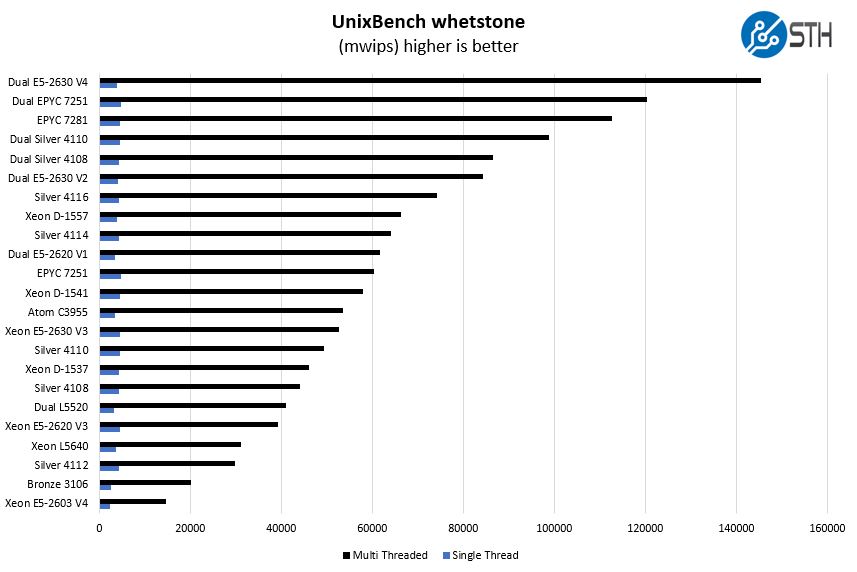
We wanted to highlight that we are now seeing a 10 core Xeon Silver part outpace two 6-core Sandy bridge parts. If you are in the Sandy Bridge generation and looking for a refresh, it will be possible to consolidate a dual CPU system into a single CPU system.
GROMACS STH Small AVX2/ AVX-512 Enabled
We have a small GROMACS molecule simulation we previewed in the first AMD EPYC 7601 Linux benchmarks piece. In Linux-Bench2 we are using a “small” test for single and dual socket capable machines. Our medium test is more appropriate for higher-end dual and quad socket machines. Our GROMACS test will use the AVX-512 and AVX2 extensions if available.
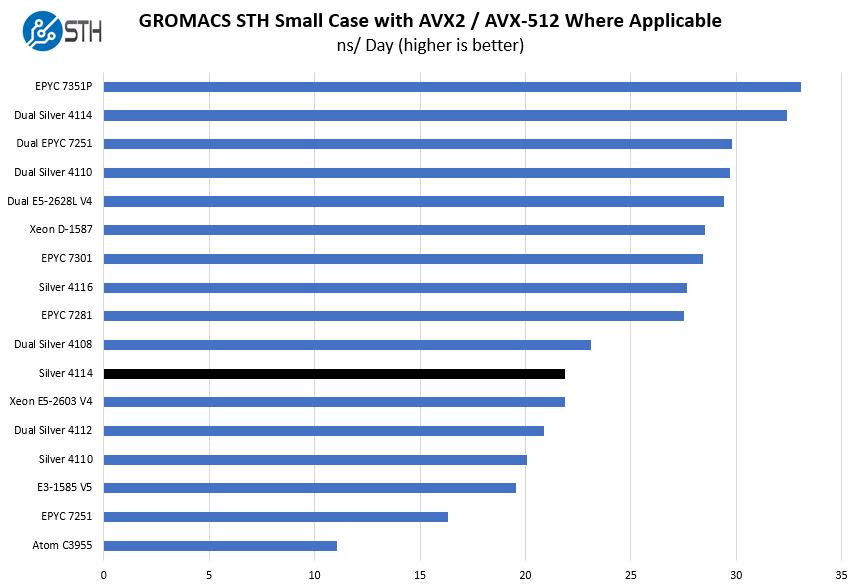
The higher clock speeds and not having cross-socket traffic is clearly helping the Xeon Silver 4114 here.
Chess Benchmarking
Chess is an interesting use case since it has almost unlimited complexity. Over the years, we have received a number of requests to bring back chess benchmarking. We have been profiling systems and are ready to start sharing results:
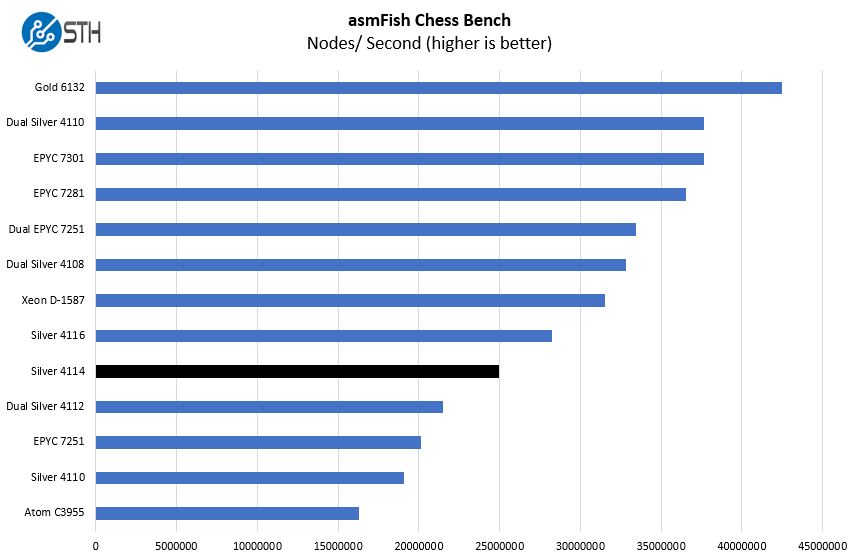
We generally express a preference for a single socket Xeon Silver 4114 over dual Silver 4112’s, and this is a good example of why. Even with two 4 core CPUs, the Silver 4114 is considerably faster. 25% more cores and a higher clock speed help the Silver 4114 also seperate from the Silver 4110.
A Note on Power Consumption
We normally only publish power consumption data on full systems we review. There are too many variables for this data to land in a CPU test. At the same time, we wanted to highlight the Intel Xeon Silver 4114 which hit a maximum of around 101W measured at the outlet in our testing. While it may be an 85W TDP part, with 10Gbase-T links active, a SAS 3008 12gbps controller and a number of drives / DIMMs in the system, the TDP rating is significantly higher than actual power consumption.
Market Positioning
This is certainly an intriguing part. It is about $200 more than the Intel Xeon Silver 4110 with only 8 cores. In terms of single thread performance, the Intel Xeon Silver line is amazingly similar based on the 3.0GHz max turbo clocks across the board. In multi-threaded workloads is where the extra cores and higher base frequencies help.
If you are purchasing a server, $200 is a 40% premium for about 30% more multi-threaded performance, and similar single core performance, compared to the Xeon Silver 4110. In a $2000 server, that is really a 10% premium. Likewise in a $5000 server with add-in cards and storage, it is a negligible additional 4%.
If you are comparing to the previous generation Intel Xeon E5-2630 V4 you are getting the same number of cores for a 10% or so premium and lower maximum turbo speeds. You do get more PCIe lanes, more DDR4 memory channels, but it is slightly unnerving to see Intel charging more for a similar part that comes out a full generation later. While Xeon Silver does get AVX-512, it receives the neutered version compared to Xeon Gold and Platinum. Likewise, the higher-end RAS features are found only on the higher-end chips.
The “elephant in the room” is AMD EPYC. At around $700, you are in price ranges of 16 core EPYC parts (e.g. the EPYC 7351P and EPYC 7281.) You can make an argument that Intel has some per-core performance advantages, but the advantage Intel has is not 60% per core. EPYC has the larger platform (8 DDR4 channels per socket and 128 PCIe lanes) but uses more power. The strange part here is that Intel is essentially increasing pricing just as AMD entered as legitimate competition.
Final Words
One may have noticed that we have tested a huge segment of the market. The sub $1500 per CPU market accounts for around 50% of the total CPU volume from what we are told. In most servers, this is a good upgrade over the Xeon Silver 4110. For a quick reference, here is the order, in terms of performance, of the Xeon Silver line:
4112 -> 4108 -> 4110 -> 4114 -> 4116
Unless you are under an expensive per-core licensing regime, skip the Xeon Silver 4112. Feel free to read about that chip more in our Intel Xeon Silver 4112 Linux Benchmarks and Review. Otherwise, this is a significant and worthy step up from the Xeon Silver 4110.

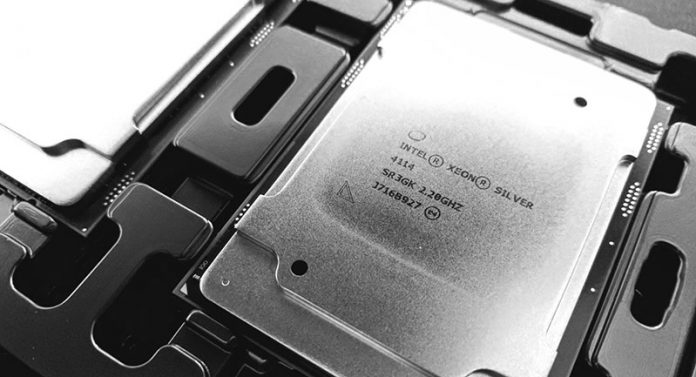



“If you are comparing to the previous generation Intel Xeon E5-2630 V4 you are getting the same number of cores for a 10% or so premium and lower maximum turbo speeds.” — tells everything. Generally speaking where EPYC is available, then Skylake-SP positioning is kind of problematic. You also noted this by your last paragraph before final words.
Anyway, thanks a lot for this honest set of reviews!
+1 to KarelG I saw this on the RSS feed and I’m totally taken aback. This is not just another review. This is the guide to sub $1k CPU options of this generation.
EPYC looks HOT
Har har! I thought this was just another CPU review at STH. This is some kinda review from the future. How many world first CPW benchmarks are presented in these charts? Ya’ll are doin’ some crazy stuff at STH. Keep it up.
“Unless you are under an expensive per-core licensing regime” – currently anybody using current versions of MS Windows Server is under this sort of regime.
TedB – agreed on Windows. There are other applications licensed in this fashion as well so we were a bit more general.
This is really helpful stuff.
I had been thinking about the Silver 4112 in a server build, but was amazed that in the single-threaded benchmark, the 4114 is superior.
I thought the extra 400mhz of the Silver 4112 would be of noticable benefit. I was wrong.
So thanks for taking the time to review these processors.